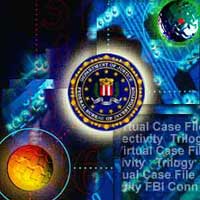IT
NFRASTRUCTURE FOR 21ST CENTURY CRIME
CIO Zal Azmi Talks About the FBI's Technology
Make Over
04/02/04
 Chief
Information Officer Zal Azmi has been onboard at FBIHQ for four months–time
enough, he says, to create and begin implementing a multi-year strategic technology
plan for the FBI, much as he did for the Executive Office for United States Attorneys
at the Department of Justice.
Chief
Information Officer Zal Azmi has been onboard at FBIHQ for four months–time
enough, he says, to create and begin implementing a multi-year strategic technology
plan for the FBI, much as he did for the Executive Office for United States Attorneys
at the Department of Justice.
"Tell
us the details," we asked, "give us a report card on where we're going
and how far we've come."
Mr.
Azmi: It's a pretty good report card, thanks to the outstanding support
we've had from Congress. We're on the right path to complete modernization and
overhaul of our information technology environment–which, by the way, is
a hugely ambitious IT project given where we started in 2001. Have we met every
deadline we've set? Unfortunately, no. Lots of uncontrollable internal and external
drivers and events have caused delays–including mid course corrections to
take advantage of newly developed technologies. But that shouldn't overshadow
the incredible progress that's been made.
Director
Mueller arrived at HQ in September 2001 with a vision to transform the FBI's technology
infrastructure–and fast. By December 2002, some 30,000 employees in 622
different locations had had their outdated hardware replaced–and three months
after that, the FBI wide area network was replaced. Operating systems and email
applications are now in the last stages of being updated. Full-site network capability
will be completed late this spring. The last piece of the puzzle is imminent:
a relational database with a web interface called Virtual Case File that will
collect ALL investigative information relating to criminal cases and national
security investigations for FBI employees to search and analyze.
Can
you take a minute to describe your immediate goals for the FBI's IT future–where
we're going?
Mr.
Azmi: Bottom
line, we're going to an FBI-wide enterprise architecture. The groundwork is essentially
done for that. We've mapped our existing resources and needs; we've anchored our
developing FBI-wide information technology strategic plan in the operational strategic
plans of the FBI and Department of Justice so it maps directly to Director Mueller's
top ten priorities; and we're matching our existing IT capabilities against the
current and future needs of our operational divisions, so we can identify any
gaps...and fill them with new IT capabilities.
What about right this minute? You've talked about the progress that's
been made, but what about that Virtual Case File system, that last-piece-of-the-puzzle
application that was delayed by the contractor. What's the schedule for getting
the full deliverable...and then deploying it?
Mr.
Azmi: It's
true about the delay. When we received the first deliverable of the VCF application
it lacked some mandatory workflow processes. We had no choice but to send it back
for corrections. As Director Mueller stressed in his Senate Appropriations testimony
last week, we are currently working closely with CSC contractors to ensure we
have a network with full site capability by late spring. Only when we get the
new cost and delivery schedule from the SAIC contractors to complete the delivery
of VCF can we nail down exactly what we can deploy and when. We need to test it
and see hands-on what applications and capabilities can be deployed with the least
risk of interrupting the operational work of the FBI. It's a delicate operation,
as you can imagine–it is like trying to operate on a runner's legs to improve
circulation while she's full tilt running the marathon. Our goal is to deliver
the first release of the VCF application later this year--a complete replacement
of our current case management system with significant enhancements...then watch
its use in the field for at least several months before adding more capabilities.
One thing you can count on: VCF must be operational before we add any additional
enhancements.
How
will technology support FBI investigations 5 years from now...and what else will
it support?
Mr.
Azmi: I will
be able to tell you more when we complete our IT strategic plan because it will
highlight the gaps and identify what's missing. However, I can tell you that in
five years we will have a very modern information technology infrastructure capable
of supporting our users from anywhere at anytime. Our goal is to provide the right
information, to the appropriate people, when they need it.
Beyond
that, the information management, search and retrieval of information, analysis
and dissemination will be seamless. We will be more aligned with NARA, FISMA and
E-Gov requirements. We intend to sustain an agile state-of-the-art IT infrastructure
that will close the communication gap with all of our law enforcement partners
and the intelligence community and, above all, solve cases and protect the American
people.
Links:
Press Release | FBI
Cyber Division | Innocent Images National
Initiative
